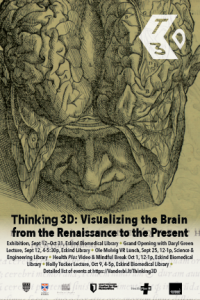
Opening on September 12, 2019, this exhibition at Vanderbilt’s Annette and Irwin Eskind Family Biomedical Library, part of a collaborative international year-long initiative with Oxford University, the University of St. Andrews, and the Royal College of Physicians, London, explored the history of the concept of three-dimensionality and its influence on human perception and technological development.
Vanderbilt’s exhibition focused on the origins of modern neuroscience, exploring human perception through studies and imagery of the brain. From the 16thcentury works of anatomist Andreas Vesalius to stereograms to the latest 3D scanning techniques, the exhibition examined the physical and virtual ways that scientists have sought to depict and explain brain anatomy and function. Three-dimensional perception itself was a topic of this exhibition as well. Dynamic programs were held around this topic over the exhibitions three-week’ run.
- Daryl Green, librarian Magdalen College and co-director of Thinking 3D presented a lecture at the grand opening on the making of the exhibition.
- Vanderbilt University Assistant Professor Ole Molvig gave a lunchtime talk and demonstration of Virtual Reality technology
- Vanderbilt’s Health Plus offered a mindful break: “Brain Health: Don’t Just Survive, Thrive!”
- Vanderbilt Professor Holly Tucker, Mellon Foundation Chair in the Humanities gave the closing talk on “Anatomy and the Early Modern Mind.”
This innovative project put minds of the 21st century in touch with those of early practitioners in neuroscience to explore biological, practical, and conceptual aspects of three-dimensionality in innovative and fascinating ways.